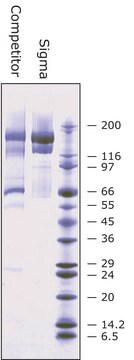M6514
3-(Trimethoxysilyl)propyl methacrylate
≥97%
Synonym(s):
Silane A174, [3-(Methacryloyloxy)propyl]trimethoxysilane
Sign Into View Organizational & Contract Pricing
All Photos(1)
About This Item
Linear Formula:
H2C=C(CH3)CO2(CH2)3Si(OCH3)3
CAS Number:
Molecular Weight:
248.35
Beilstein:
1952435
EC Number:
MDL number:
UNSPSC Code:
47101511
PubChem Substance ID:
NACRES:
NA.56
Recommended Products
Quality Level
Assay
≥97%
form
liquid
refractive index
n20/D 1.431 (lit.)
bp
190 °C (lit.)
density
1.045 g/mL at 25 °C (lit.)
storage temp.
2-8°C
SMILES string
CO[Si](CCCOC(=O)C(C)=C)(OC)OC
InChI
1S/C10H20O5Si/c1-9(2)10(11)15-7-6-8-16(12-3,13-4)14-5/h1,6-8H2,2-5H3
InChI key
XDLMVUHYZWKMMD-UHFFFAOYSA-N
Looking for similar products? Visit Product Comparison Guide
General description
3-(Trimethoxysilyl)propyl methacrylate (TMSPMA) is a hydrophobic monomer. The presence of an additional functional group of acrylate facilitates TMSPMA for grafting polymerization on plastic surfaces. 3-(Trimethoxysilyl)propyl methacrylate undergoes first-order kinetic polymerization to form polyTMSPMA, which is a moisture stable polymer.
Application
3-(Trimethoxysilyl)propyl methacrylate has been used in the following applications:
- Isoelectric focusing can lead to pH gradient formation resulting in the swelling or shrinking of gel casts. This can be prevented by using 3-(Trimethoxysilyl)propyl methacrylate to link polyacrylamide gels to glass plates covalently.
- In situ hybridization using 3-(Trimethoxysilyl)propyl methacrylate along with poly-L-lysine is a faster and durable method to attach cells, microscopic sections, and total organs to slides/other glass surfaces.
- 3-(Trimethoxysilyl)propyl methacrylate is also used in the preparation of organic/inorganic hybrid nanomaterials.
Packaging
A product Information sheet is supplied which describes procedures for using this product.
related product
Product No.
Description
Pricing
Storage Class Code
10 - Combustible liquids
WGK
WGK 1
Flash Point(F)
197.6 °F - closed cup
Flash Point(C)
92 °C - closed cup
Personal Protective Equipment
dust mask type N95 (US), Eyeshields, Gloves
Choose from one of the most recent versions:
Already Own This Product?
Find documentation for the products that you have recently purchased in the Document Library.
Customers Also Viewed
Sean Brahim et al.
Biomacromolecules, 4(5), 1224-1231 (2003-09-10)
An amphiphilic hydrogel of poly(2-hydroxyethyl methacrylate) cross-linked with tetraethyleneglycol diacrylate (TEGDA) was synthesized to contain the hydrophobic monomer 3-(trimethoxy-silyl) propyl methacrylate (PMA) and the pH-responsive, hydrophilic monomer N',N'-dimethylaminoethyl methacrylate (DMAEMA). The gels were separately loaded with two biomolecular probes, insulin
ATRP of 3-(triethoxysilyl)propyl methacrylate and preparation of ?stable? gelable block copolymers
Ming Xiong
European Polymer Journal, 44, 3835-3841 (2008)
M Aguadé et al.
Proceedings of the National Academy of Sciences of the United States of America, 91(11), 4658-4662 (1994-05-24)
Single-strand conformation polymorphism (SSCP) analysis followed by DNA sequencing of stratified sub-samples was used to survey DNA polymorphism in the su(s) and su(wa) regions in a natural population of Drosophila melanogaster. su(s) and su(wa) are located near the telomere of
Bozhen Zhang et al.
Journal of materials chemistry. B, 9(35), 7196-7204 (2021-07-23)
Label-free cell sorting devices are of great significance for biomedical research and clinical therapeutics. However, current platforms for label-free cell sorting cannot achieve continuity and selectivity simultaneously, resulting in complex steps and limited reliability. Here, an immunoaffinity-based cell catch-transport-release thermo-chemo-mechanical
Ke Liu et al.
Journal of colloid and interface science, 365(1), 289-295 (2011-10-04)
Thermoplastics have been increasingly used for fabricating microfluidic devices because of their low cost, mechanical/biocompatible attributes, and well-established manufacturing processes. However, there is sometimes a need to integrate such a device with components made from other materials such as polydimethylsiloxane
Our team of scientists has experience in all areas of research including Life Science, Material Science, Chemical Synthesis, Chromatography, Analytical and many others.
Contact Technical Service






![3-[Tris(trimethylsiloxy)silyl]propyl methacrylate contains MEHQ + HQ as stabilizer, 98%](/deepweb/assets/sigmaaldrich/product/structures/148/664/33ff5116-f264-4a64-824a-009c2ca5b2b3/640/33ff5116-f264-4a64-824a-009c2ca5b2b3.png)


